Event Planning and Project Management Analysis for NSPCC Campaign
VerifiedAdded on 2020/10/05
|14
|4037
|219
Report
AI Summary
This report delves into the intricacies of event planning and project management, focusing on key concepts and practical applications. It begins by defining event planning and project management, highlighting their characteristics and the life cycles involved. The report uses the NSPCC (National Society for the Prevention of Cruelty to Children) as a case study, exploring how event planning and project management principles can be applied to their campaigns. It examines the EMBOK (Event Management Body of Knowledge) model, illustrating its processes and phases in the context of NSPCC's objectives. Furthermore, it discusses various techniques essential for successful event planning and project management, providing a comprehensive overview of the subject matter. The report covers event planning models, project management life cycles, and the application of these concepts to real-world scenarios, making it a valuable resource for anyone interested in the field.

Event Planning
and
Project Management
and
Project Management
Secure Best Marks with AI Grader
Need help grading? Try our AI Grader for instant feedback on your assignments.

Table of Contents
INTRODUCTION...........................................................................................................................3
TASK 1............................................................................................................................................3
A) Define event planning and project management....................................................................3
B) Key characteristics of projects and events.............................................................................4
C) Event planning and project management life cycle...............................................................5
TASK 2............................................................................................................................................8
A) Event planning model............................................................................................................8
B) Techniques for event planning and project management.....................................................12
CONCLUSION..............................................................................................................................13
REFERENCES..............................................................................................................................14
INTRODUCTION...........................................................................................................................3
TASK 1............................................................................................................................................3
A) Define event planning and project management....................................................................3
B) Key characteristics of projects and events.............................................................................4
C) Event planning and project management life cycle...............................................................5
TASK 2............................................................................................................................................8
A) Event planning model............................................................................................................8
B) Techniques for event planning and project management.....................................................12
CONCLUSION..............................................................................................................................13
REFERENCES..............................................................................................................................14
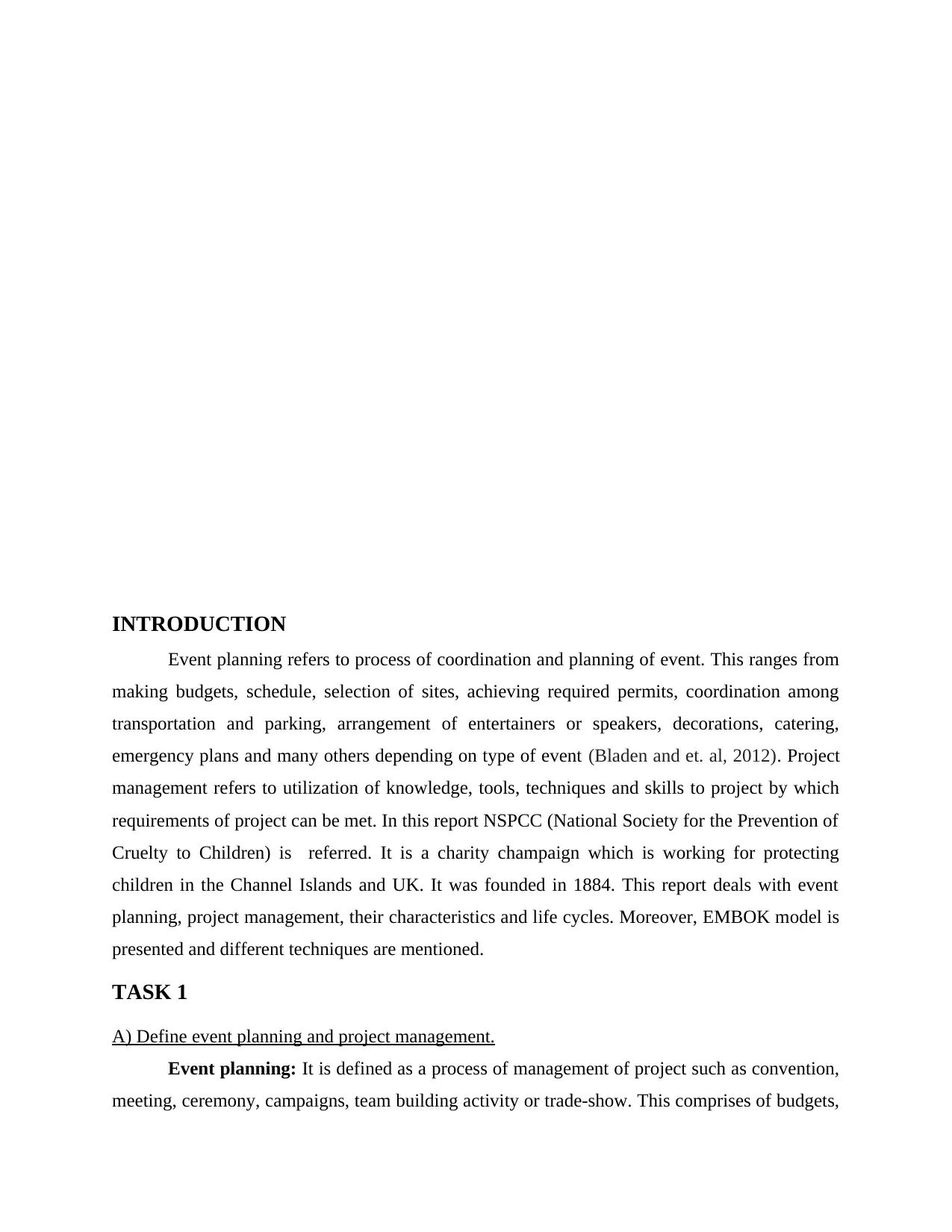
INTRODUCTION
Event planning refers to process of coordination and planning of event. This ranges from
making budgets, schedule, selection of sites, achieving required permits, coordination among
transportation and parking, arrangement of entertainers or speakers, decorations, catering,
emergency plans and many others depending on type of event (Bladen and et. al, 2012). Project
management refers to utilization of knowledge, tools, techniques and skills to project by which
requirements of project can be met. In this report NSPCC (National Society for the Prevention of
Cruelty to Children) is referred. It is a charity champaign which is working for protecting
children in the Channel Islands and UK. It was founded in 1884. This report deals with event
planning, project management, their characteristics and life cycles. Moreover, EMBOK model is
presented and different techniques are mentioned.
TASK 1
A) Define event planning and project management.
Event planning: It is defined as a process of management of project such as convention,
meeting, ceremony, campaigns, team building activity or trade-show. This comprises of budgets,
Event planning refers to process of coordination and planning of event. This ranges from
making budgets, schedule, selection of sites, achieving required permits, coordination among
transportation and parking, arrangement of entertainers or speakers, decorations, catering,
emergency plans and many others depending on type of event (Bladen and et. al, 2012). Project
management refers to utilization of knowledge, tools, techniques and skills to project by which
requirements of project can be met. In this report NSPCC (National Society for the Prevention of
Cruelty to Children) is referred. It is a charity champaign which is working for protecting
children in the Channel Islands and UK. It was founded in 1884. This report deals with event
planning, project management, their characteristics and life cycles. Moreover, EMBOK model is
presented and different techniques are mentioned.
TASK 1
A) Define event planning and project management.
Event planning: It is defined as a process of management of project such as convention,
meeting, ceremony, campaigns, team building activity or trade-show. This comprises of budgets,
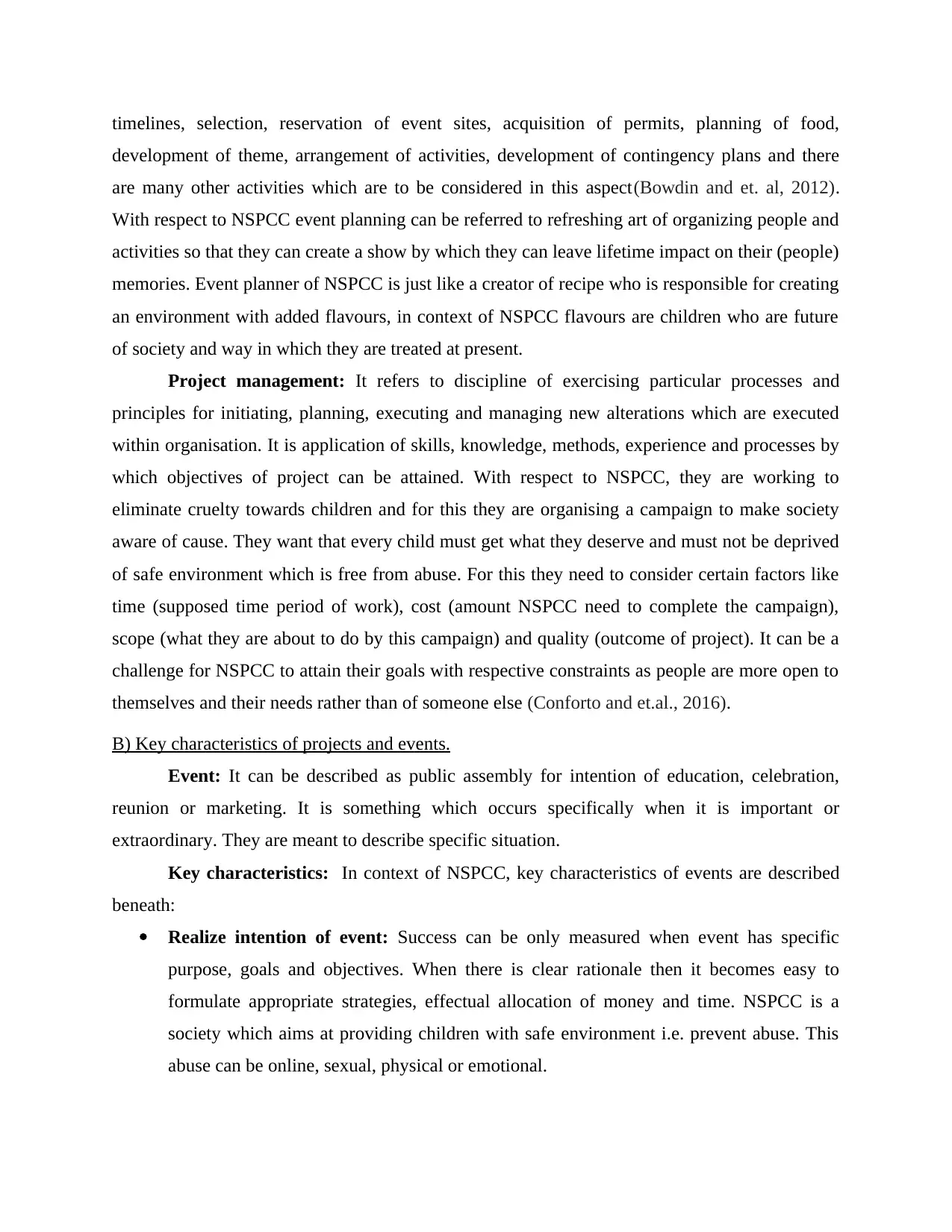
timelines, selection, reservation of event sites, acquisition of permits, planning of food,
development of theme, arrangement of activities, development of contingency plans and there
are many other activities which are to be considered in this aspect(Bowdin and et. al, 2012).
With respect to NSPCC event planning can be referred to refreshing art of organizing people and
activities so that they can create a show by which they can leave lifetime impact on their (people)
memories. Event planner of NSPCC is just like a creator of recipe who is responsible for creating
an environment with added flavours, in context of NSPCC flavours are children who are future
of society and way in which they are treated at present.
Project management: It refers to discipline of exercising particular processes and
principles for initiating, planning, executing and managing new alterations which are executed
within organisation. It is application of skills, knowledge, methods, experience and processes by
which objectives of project can be attained. With respect to NSPCC, they are working to
eliminate cruelty towards children and for this they are organising a campaign to make society
aware of cause. They want that every child must get what they deserve and must not be deprived
of safe environment which is free from abuse. For this they need to consider certain factors like
time (supposed time period of work), cost (amount NSPCC need to complete the campaign),
scope (what they are about to do by this campaign) and quality (outcome of project). It can be a
challenge for NSPCC to attain their goals with respective constraints as people are more open to
themselves and their needs rather than of someone else (Conforto and et.al., 2016).
B) Key characteristics of projects and events.
Event: It can be described as public assembly for intention of education, celebration,
reunion or marketing. It is something which occurs specifically when it is important or
extraordinary. They are meant to describe specific situation.
Key characteristics: In context of NSPCC, key characteristics of events are described
beneath:
Realize intention of event: Success can be only measured when event has specific
purpose, goals and objectives. When there is clear rationale then it becomes easy to
formulate appropriate strategies, effectual allocation of money and time. NSPCC is a
society which aims at providing children with safe environment i.e. prevent abuse. This
abuse can be online, sexual, physical or emotional.
development of theme, arrangement of activities, development of contingency plans and there
are many other activities which are to be considered in this aspect(Bowdin and et. al, 2012).
With respect to NSPCC event planning can be referred to refreshing art of organizing people and
activities so that they can create a show by which they can leave lifetime impact on their (people)
memories. Event planner of NSPCC is just like a creator of recipe who is responsible for creating
an environment with added flavours, in context of NSPCC flavours are children who are future
of society and way in which they are treated at present.
Project management: It refers to discipline of exercising particular processes and
principles for initiating, planning, executing and managing new alterations which are executed
within organisation. It is application of skills, knowledge, methods, experience and processes by
which objectives of project can be attained. With respect to NSPCC, they are working to
eliminate cruelty towards children and for this they are organising a campaign to make society
aware of cause. They want that every child must get what they deserve and must not be deprived
of safe environment which is free from abuse. For this they need to consider certain factors like
time (supposed time period of work), cost (amount NSPCC need to complete the campaign),
scope (what they are about to do by this campaign) and quality (outcome of project). It can be a
challenge for NSPCC to attain their goals with respective constraints as people are more open to
themselves and their needs rather than of someone else (Conforto and et.al., 2016).
B) Key characteristics of projects and events.
Event: It can be described as public assembly for intention of education, celebration,
reunion or marketing. It is something which occurs specifically when it is important or
extraordinary. They are meant to describe specific situation.
Key characteristics: In context of NSPCC, key characteristics of events are described
beneath:
Realize intention of event: Success can be only measured when event has specific
purpose, goals and objectives. When there is clear rationale then it becomes easy to
formulate appropriate strategies, effectual allocation of money and time. NSPCC is a
society which aims at providing children with safe environment i.e. prevent abuse. This
abuse can be online, sexual, physical or emotional.
Secure Best Marks with AI Grader
Need help grading? Try our AI Grader for instant feedback on your assignments.
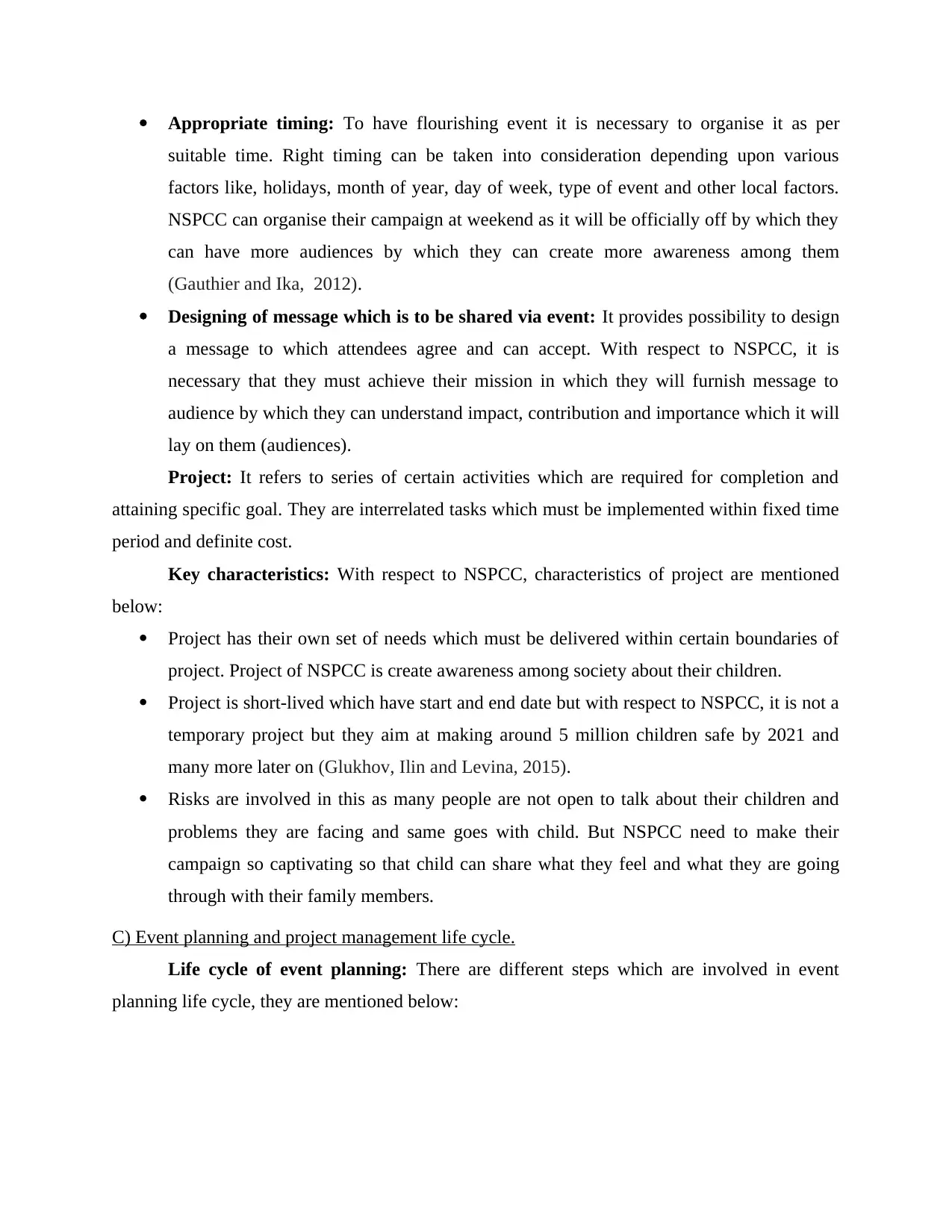
Appropriate timing: To have flourishing event it is necessary to organise it as per
suitable time. Right timing can be taken into consideration depending upon various
factors like, holidays, month of year, day of week, type of event and other local factors.
NSPCC can organise their campaign at weekend as it will be officially off by which they
can have more audiences by which they can create more awareness among them
(Gauthier and Ika, 2012).
Designing of message which is to be shared via event: It provides possibility to design
a message to which attendees agree and can accept. With respect to NSPCC, it is
necessary that they must achieve their mission in which they will furnish message to
audience by which they can understand impact, contribution and importance which it will
lay on them (audiences).
Project: It refers to series of certain activities which are required for completion and
attaining specific goal. They are interrelated tasks which must be implemented within fixed time
period and definite cost.
Key characteristics: With respect to NSPCC, characteristics of project are mentioned
below:
Project has their own set of needs which must be delivered within certain boundaries of
project. Project of NSPCC is create awareness among society about their children.
Project is short-lived which have start and end date but with respect to NSPCC, it is not a
temporary project but they aim at making around 5 million children safe by 2021 and
many more later on (Glukhov, Ilin and Levina, 2015).
Risks are involved in this as many people are not open to talk about their children and
problems they are facing and same goes with child. But NSPCC need to make their
campaign so captivating so that child can share what they feel and what they are going
through with their family members.
C) Event planning and project management life cycle.
Life cycle of event planning: There are different steps which are involved in event
planning life cycle, they are mentioned below:
suitable time. Right timing can be taken into consideration depending upon various
factors like, holidays, month of year, day of week, type of event and other local factors.
NSPCC can organise their campaign at weekend as it will be officially off by which they
can have more audiences by which they can create more awareness among them
(Gauthier and Ika, 2012).
Designing of message which is to be shared via event: It provides possibility to design
a message to which attendees agree and can accept. With respect to NSPCC, it is
necessary that they must achieve their mission in which they will furnish message to
audience by which they can understand impact, contribution and importance which it will
lay on them (audiences).
Project: It refers to series of certain activities which are required for completion and
attaining specific goal. They are interrelated tasks which must be implemented within fixed time
period and definite cost.
Key characteristics: With respect to NSPCC, characteristics of project are mentioned
below:
Project has their own set of needs which must be delivered within certain boundaries of
project. Project of NSPCC is create awareness among society about their children.
Project is short-lived which have start and end date but with respect to NSPCC, it is not a
temporary project but they aim at making around 5 million children safe by 2021 and
many more later on (Glukhov, Ilin and Levina, 2015).
Risks are involved in this as many people are not open to talk about their children and
problems they are facing and same goes with child. But NSPCC need to make their
campaign so captivating so that child can share what they feel and what they are going
through with their family members.
C) Event planning and project management life cycle.
Life cycle of event planning: There are different steps which are involved in event
planning life cycle, they are mentioned below:
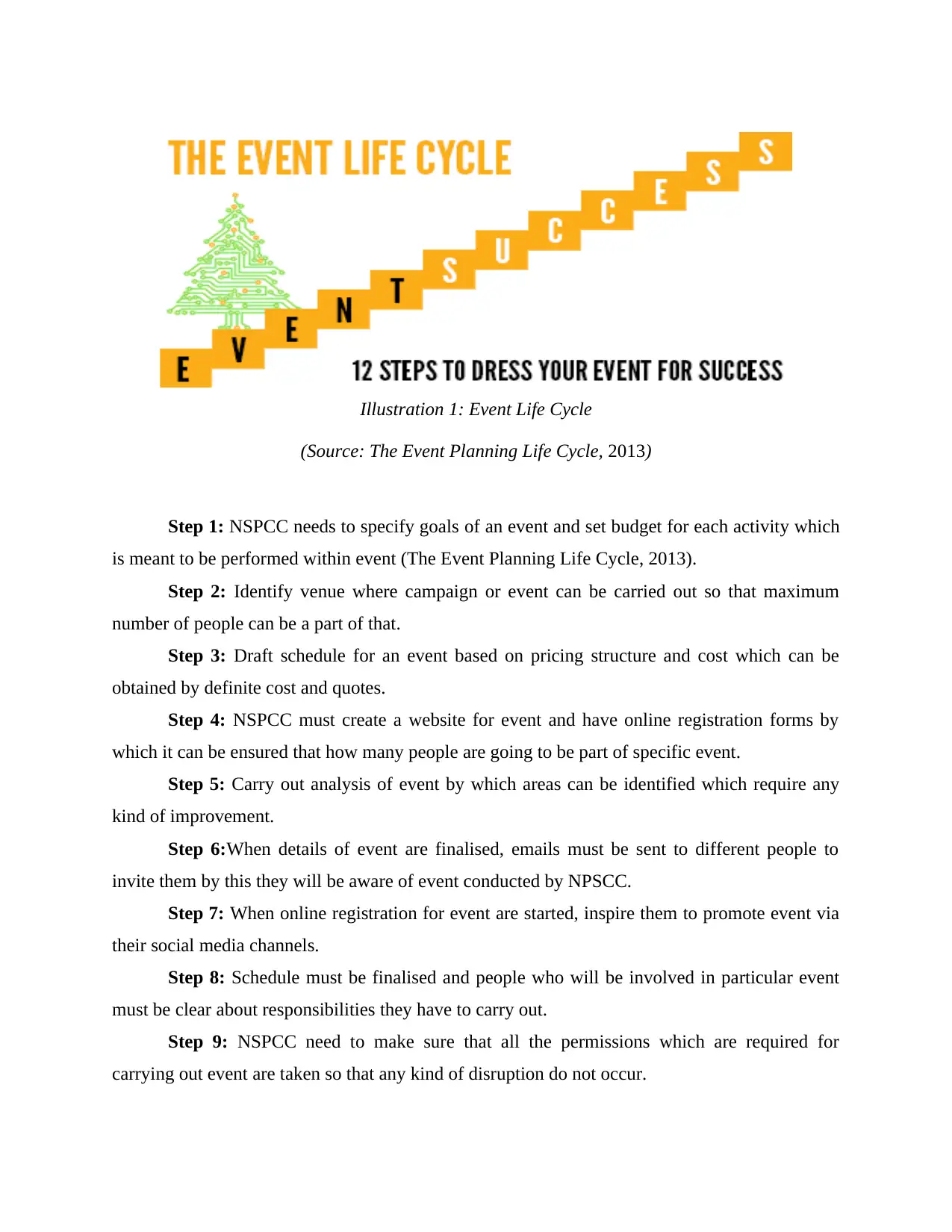
Step 1: NSPCC needs to specify goals of an event and set budget for each activity which
is meant to be performed within event (The Event Planning Life Cycle, 2013).
Step 2: Identify venue where campaign or event can be carried out so that maximum
number of people can be a part of that.
Step 3: Draft schedule for an event based on pricing structure and cost which can be
obtained by definite cost and quotes.
Step 4: NSPCC must create a website for event and have online registration forms by
which it can be ensured that how many people are going to be part of specific event.
Step 5: Carry out analysis of event by which areas can be identified which require any
kind of improvement.
Step 6:When details of event are finalised, emails must be sent to different people to
invite them by this they will be aware of event conducted by NPSCC.
Step 7: When online registration for event are started, inspire them to promote event via
their social media channels.
Step 8: Schedule must be finalised and people who will be involved in particular event
must be clear about responsibilities they have to carry out.
Step 9: NSPCC need to make sure that all the permissions which are required for
carrying out event are taken so that any kind of disruption do not occur.
Illustration 1: Event Life Cycle
(Source: The Event Planning Life Cycle, 2013)
is meant to be performed within event (The Event Planning Life Cycle, 2013).
Step 2: Identify venue where campaign or event can be carried out so that maximum
number of people can be a part of that.
Step 3: Draft schedule for an event based on pricing structure and cost which can be
obtained by definite cost and quotes.
Step 4: NSPCC must create a website for event and have online registration forms by
which it can be ensured that how many people are going to be part of specific event.
Step 5: Carry out analysis of event by which areas can be identified which require any
kind of improvement.
Step 6:When details of event are finalised, emails must be sent to different people to
invite them by this they will be aware of event conducted by NPSCC.
Step 7: When online registration for event are started, inspire them to promote event via
their social media channels.
Step 8: Schedule must be finalised and people who will be involved in particular event
must be clear about responsibilities they have to carry out.
Step 9: NSPCC need to make sure that all the permissions which are required for
carrying out event are taken so that any kind of disruption do not occur.
Illustration 1: Event Life Cycle
(Source: The Event Planning Life Cycle, 2013)
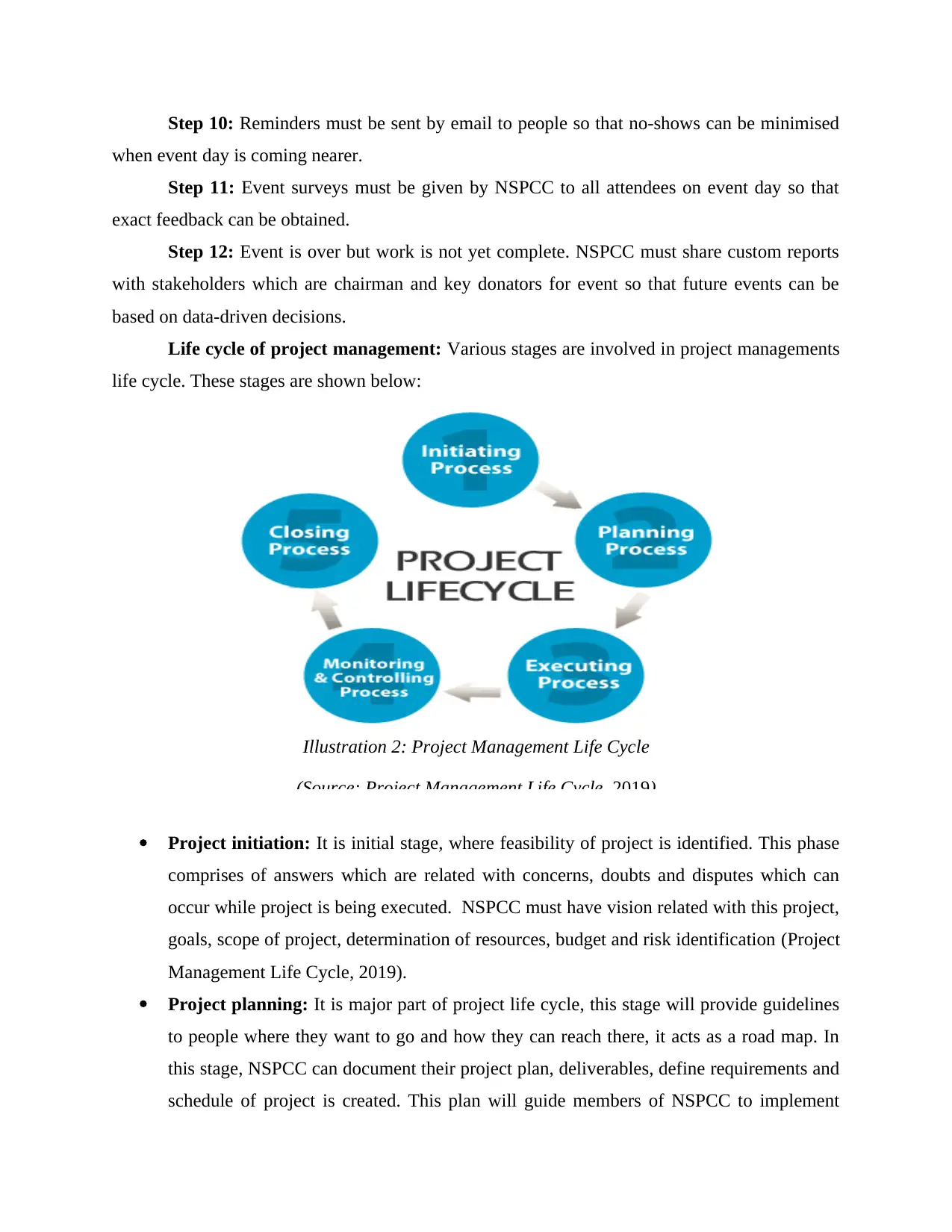
Step 10: Reminders must be sent by email to people so that no-shows can be minimised
when event day is coming nearer.
Step 11: Event surveys must be given by NSPCC to all attendees on event day so that
exact feedback can be obtained.
Step 12: Event is over but work is not yet complete. NSPCC must share custom reports
with stakeholders which are chairman and key donators for event so that future events can be
based on data-driven decisions.
Life cycle of project management: Various stages are involved in project managements
life cycle. These stages are shown below:
Project initiation: It is initial stage, where feasibility of project is identified. This phase
comprises of answers which are related with concerns, doubts and disputes which can
occur while project is being executed. NSPCC must have vision related with this project,
goals, scope of project, determination of resources, budget and risk identification (Project
Management Life Cycle, 2019).
Project planning: It is major part of project life cycle, this stage will provide guidelines
to people where they want to go and how they can reach there, it acts as a road map. In
this stage, NSPCC can document their project plan, deliverables, define requirements and
schedule of project is created. This plan will guide members of NSPCC to implement
Illustration 2: Project Management Life Cycle
(Source: Project Management Life Cycle, 2019)
when event day is coming nearer.
Step 11: Event surveys must be given by NSPCC to all attendees on event day so that
exact feedback can be obtained.
Step 12: Event is over but work is not yet complete. NSPCC must share custom reports
with stakeholders which are chairman and key donators for event so that future events can be
based on data-driven decisions.
Life cycle of project management: Various stages are involved in project managements
life cycle. These stages are shown below:
Project initiation: It is initial stage, where feasibility of project is identified. This phase
comprises of answers which are related with concerns, doubts and disputes which can
occur while project is being executed. NSPCC must have vision related with this project,
goals, scope of project, determination of resources, budget and risk identification (Project
Management Life Cycle, 2019).
Project planning: It is major part of project life cycle, this stage will provide guidelines
to people where they want to go and how they can reach there, it acts as a road map. In
this stage, NSPCC can document their project plan, deliverables, define requirements and
schedule of project is created. This plan will guide members of NSPCC to implement
Illustration 2: Project Management Life Cycle
(Source: Project Management Life Cycle, 2019)
Paraphrase This Document
Need a fresh take? Get an instant paraphrase of this document with our AI Paraphraser
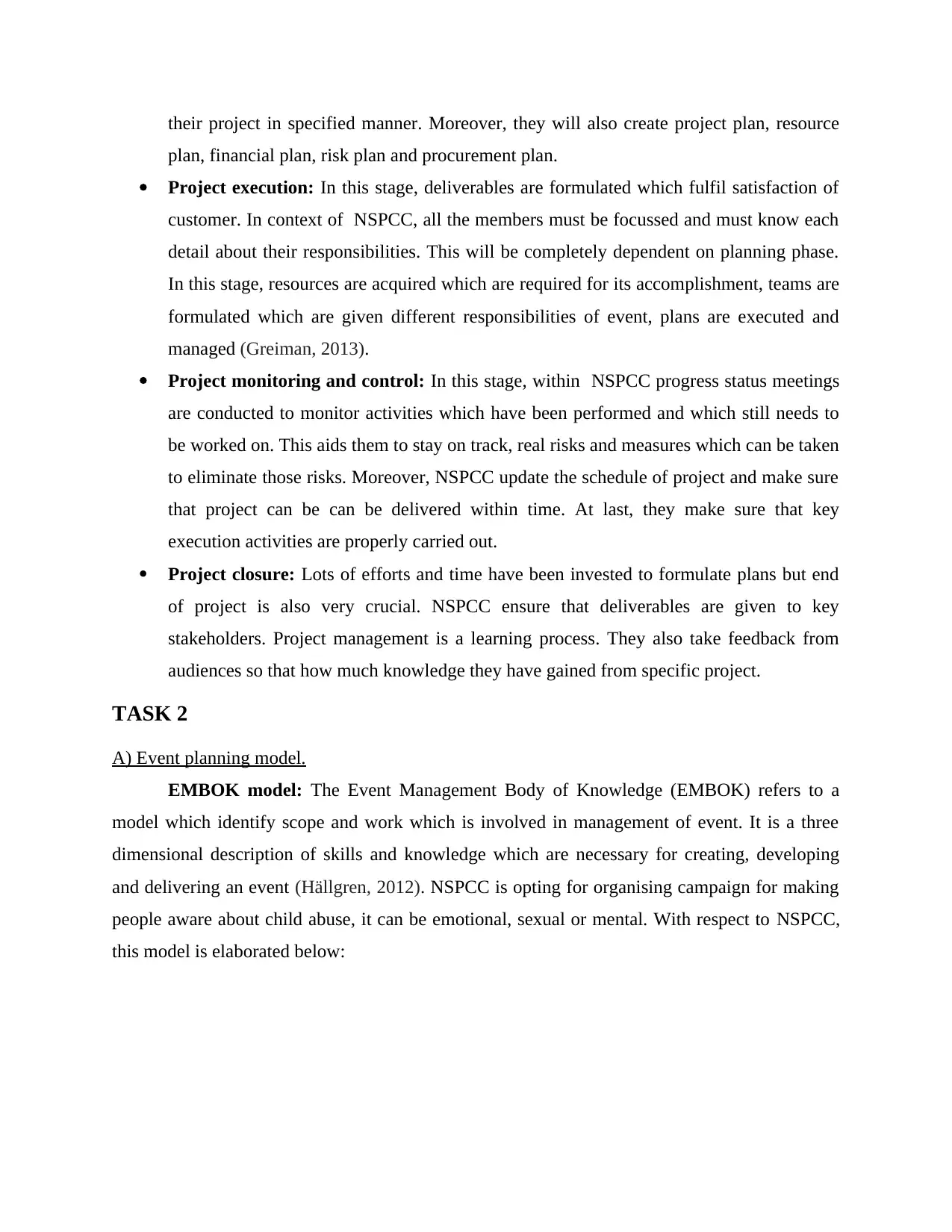
their project in specified manner. Moreover, they will also create project plan, resource
plan, financial plan, risk plan and procurement plan.
Project execution: In this stage, deliverables are formulated which fulfil satisfaction of
customer. In context of NSPCC, all the members must be focussed and must know each
detail about their responsibilities. This will be completely dependent on planning phase.
In this stage, resources are acquired which are required for its accomplishment, teams are
formulated which are given different responsibilities of event, plans are executed and
managed (Greiman, 2013).
Project monitoring and control: In this stage, within NSPCC progress status meetings
are conducted to monitor activities which have been performed and which still needs to
be worked on. This aids them to stay on track, real risks and measures which can be taken
to eliminate those risks. Moreover, NSPCC update the schedule of project and make sure
that project can be can be delivered within time. At last, they make sure that key
execution activities are properly carried out.
Project closure: Lots of efforts and time have been invested to formulate plans but end
of project is also very crucial. NSPCC ensure that deliverables are given to key
stakeholders. Project management is a learning process. They also take feedback from
audiences so that how much knowledge they have gained from specific project.
TASK 2
A) Event planning model.
EMBOK model: The Event Management Body of Knowledge (EMBOK) refers to a
model which identify scope and work which is involved in management of event. It is a three
dimensional description of skills and knowledge which are necessary for creating, developing
and delivering an event (Hällgren, 2012). NSPCC is opting for organising campaign for making
people aware about child abuse, it can be emotional, sexual or mental. With respect to NSPCC,
this model is elaborated below:
plan, financial plan, risk plan and procurement plan.
Project execution: In this stage, deliverables are formulated which fulfil satisfaction of
customer. In context of NSPCC, all the members must be focussed and must know each
detail about their responsibilities. This will be completely dependent on planning phase.
In this stage, resources are acquired which are required for its accomplishment, teams are
formulated which are given different responsibilities of event, plans are executed and
managed (Greiman, 2013).
Project monitoring and control: In this stage, within NSPCC progress status meetings
are conducted to monitor activities which have been performed and which still needs to
be worked on. This aids them to stay on track, real risks and measures which can be taken
to eliminate those risks. Moreover, NSPCC update the schedule of project and make sure
that project can be can be delivered within time. At last, they make sure that key
execution activities are properly carried out.
Project closure: Lots of efforts and time have been invested to formulate plans but end
of project is also very crucial. NSPCC ensure that deliverables are given to key
stakeholders. Project management is a learning process. They also take feedback from
audiences so that how much knowledge they have gained from specific project.
TASK 2
A) Event planning model.
EMBOK model: The Event Management Body of Knowledge (EMBOK) refers to a
model which identify scope and work which is involved in management of event. It is a three
dimensional description of skills and knowledge which are necessary for creating, developing
and delivering an event (Hällgren, 2012). NSPCC is opting for organising campaign for making
people aware about child abuse, it can be emotional, sexual or mental. With respect to NSPCC,
this model is elaborated below:
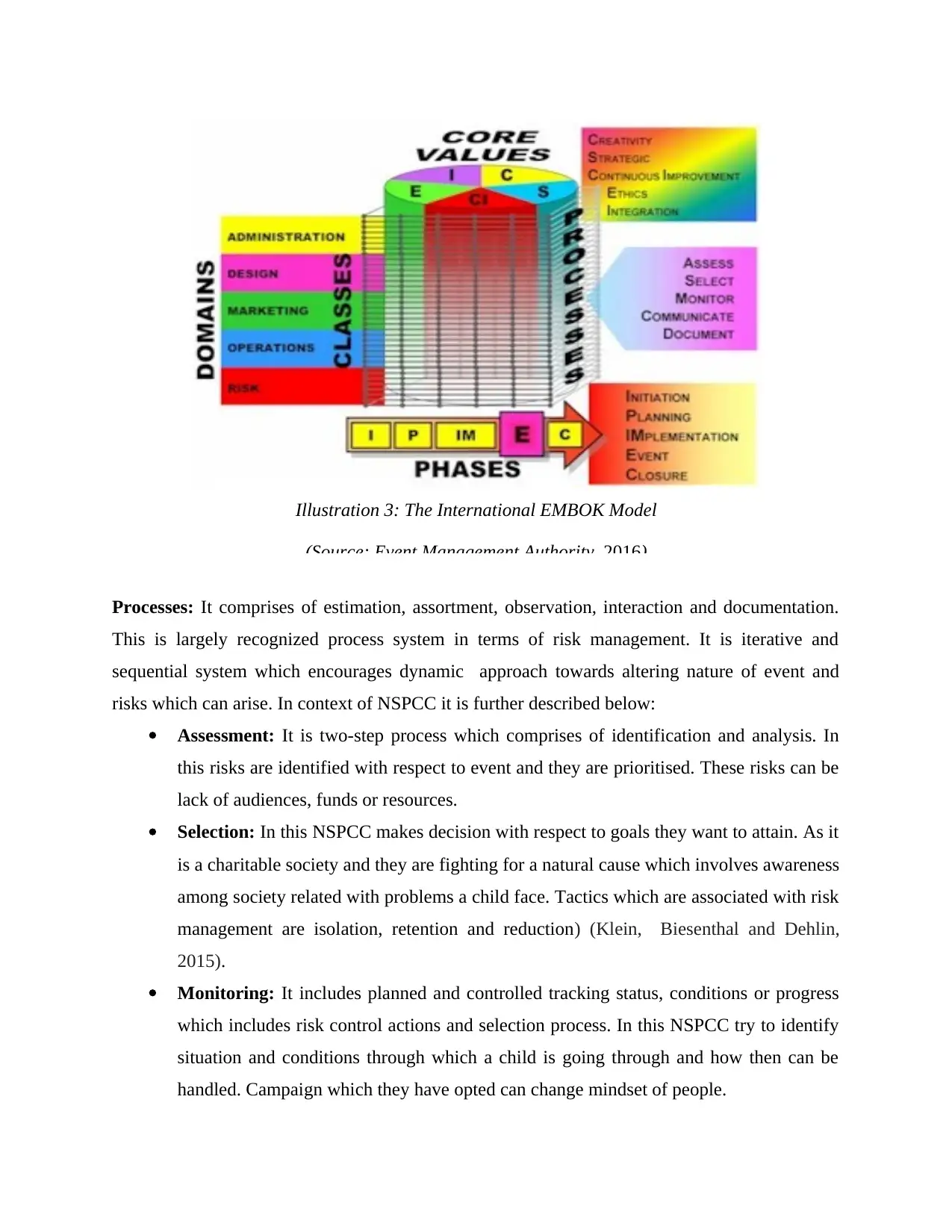
Processes: It comprises of estimation, assortment, observation, interaction and documentation.
This is largely recognized process system in terms of risk management. It is iterative and
sequential system which encourages dynamic approach towards altering nature of event and
risks which can arise. In context of NSPCC it is further described below:
Assessment: It is two-step process which comprises of identification and analysis. In
this risks are identified with respect to event and they are prioritised. These risks can be
lack of audiences, funds or resources.
Selection: In this NSPCC makes decision with respect to goals they want to attain. As it
is a charitable society and they are fighting for a natural cause which involves awareness
among society related with problems a child face. Tactics which are associated with risk
management are isolation, retention and reduction) (Klein, Biesenthal and Dehlin,
2015).
Monitoring: It includes planned and controlled tracking status, conditions or progress
which includes risk control actions and selection process. In this NSPCC try to identify
situation and conditions through which a child is going through and how then can be
handled. Campaign which they have opted can change mindset of people.
Illustration 3: The International EMBOK Model
(Source: Event Management Authority, 2016)
This is largely recognized process system in terms of risk management. It is iterative and
sequential system which encourages dynamic approach towards altering nature of event and
risks which can arise. In context of NSPCC it is further described below:
Assessment: It is two-step process which comprises of identification and analysis. In
this risks are identified with respect to event and they are prioritised. These risks can be
lack of audiences, funds or resources.
Selection: In this NSPCC makes decision with respect to goals they want to attain. As it
is a charitable society and they are fighting for a natural cause which involves awareness
among society related with problems a child face. Tactics which are associated with risk
management are isolation, retention and reduction) (Klein, Biesenthal and Dehlin,
2015).
Monitoring: It includes planned and controlled tracking status, conditions or progress
which includes risk control actions and selection process. In this NSPCC try to identify
situation and conditions through which a child is going through and how then can be
handled. Campaign which they have opted can change mindset of people.
Illustration 3: The International EMBOK Model
(Source: Event Management Authority, 2016)
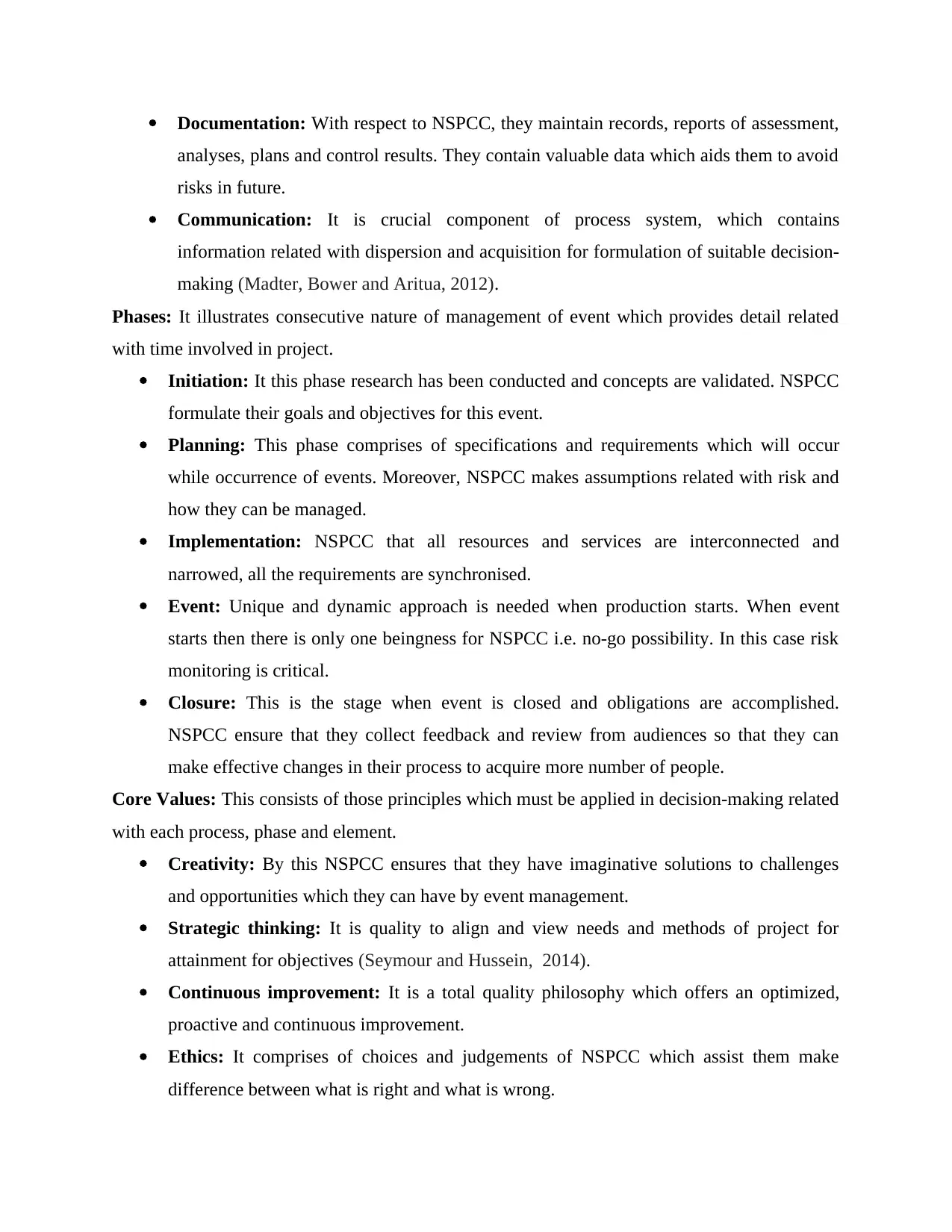
Documentation: With respect to NSPCC, they maintain records, reports of assessment,
analyses, plans and control results. They contain valuable data which aids them to avoid
risks in future.
Communication: It is crucial component of process system, which contains
information related with dispersion and acquisition for formulation of suitable decision-
making (Madter, Bower and Aritua, 2012).
Phases: It illustrates consecutive nature of management of event which provides detail related
with time involved in project.
Initiation: It this phase research has been conducted and concepts are validated. NSPCC
formulate their goals and objectives for this event.
Planning: This phase comprises of specifications and requirements which will occur
while occurrence of events. Moreover, NSPCC makes assumptions related with risk and
how they can be managed.
Implementation: NSPCC that all resources and services are interconnected and
narrowed, all the requirements are synchronised.
Event: Unique and dynamic approach is needed when production starts. When event
starts then there is only one beingness for NSPCC i.e. no-go possibility. In this case risk
monitoring is critical.
Closure: This is the stage when event is closed and obligations are accomplished.
NSPCC ensure that they collect feedback and review from audiences so that they can
make effective changes in their process to acquire more number of people.
Core Values: This consists of those principles which must be applied in decision-making related
with each process, phase and element.
Creativity: By this NSPCC ensures that they have imaginative solutions to challenges
and opportunities which they can have by event management.
Strategic thinking: It is quality to align and view needs and methods of project for
attainment for objectives (Seymour and Hussein, 2014).
Continuous improvement: It is a total quality philosophy which offers an optimized,
proactive and continuous improvement.
Ethics: It comprises of choices and judgements of NSPCC which assist them make
difference between what is right and what is wrong.
analyses, plans and control results. They contain valuable data which aids them to avoid
risks in future.
Communication: It is crucial component of process system, which contains
information related with dispersion and acquisition for formulation of suitable decision-
making (Madter, Bower and Aritua, 2012).
Phases: It illustrates consecutive nature of management of event which provides detail related
with time involved in project.
Initiation: It this phase research has been conducted and concepts are validated. NSPCC
formulate their goals and objectives for this event.
Planning: This phase comprises of specifications and requirements which will occur
while occurrence of events. Moreover, NSPCC makes assumptions related with risk and
how they can be managed.
Implementation: NSPCC that all resources and services are interconnected and
narrowed, all the requirements are synchronised.
Event: Unique and dynamic approach is needed when production starts. When event
starts then there is only one beingness for NSPCC i.e. no-go possibility. In this case risk
monitoring is critical.
Closure: This is the stage when event is closed and obligations are accomplished.
NSPCC ensure that they collect feedback and review from audiences so that they can
make effective changes in their process to acquire more number of people.
Core Values: This consists of those principles which must be applied in decision-making related
with each process, phase and element.
Creativity: By this NSPCC ensures that they have imaginative solutions to challenges
and opportunities which they can have by event management.
Strategic thinking: It is quality to align and view needs and methods of project for
attainment for objectives (Seymour and Hussein, 2014).
Continuous improvement: It is a total quality philosophy which offers an optimized,
proactive and continuous improvement.
Ethics: It comprises of choices and judgements of NSPCC which assist them make
difference between what is right and what is wrong.
Secure Best Marks with AI Grader
Need help grading? Try our AI Grader for instant feedback on your assignments.
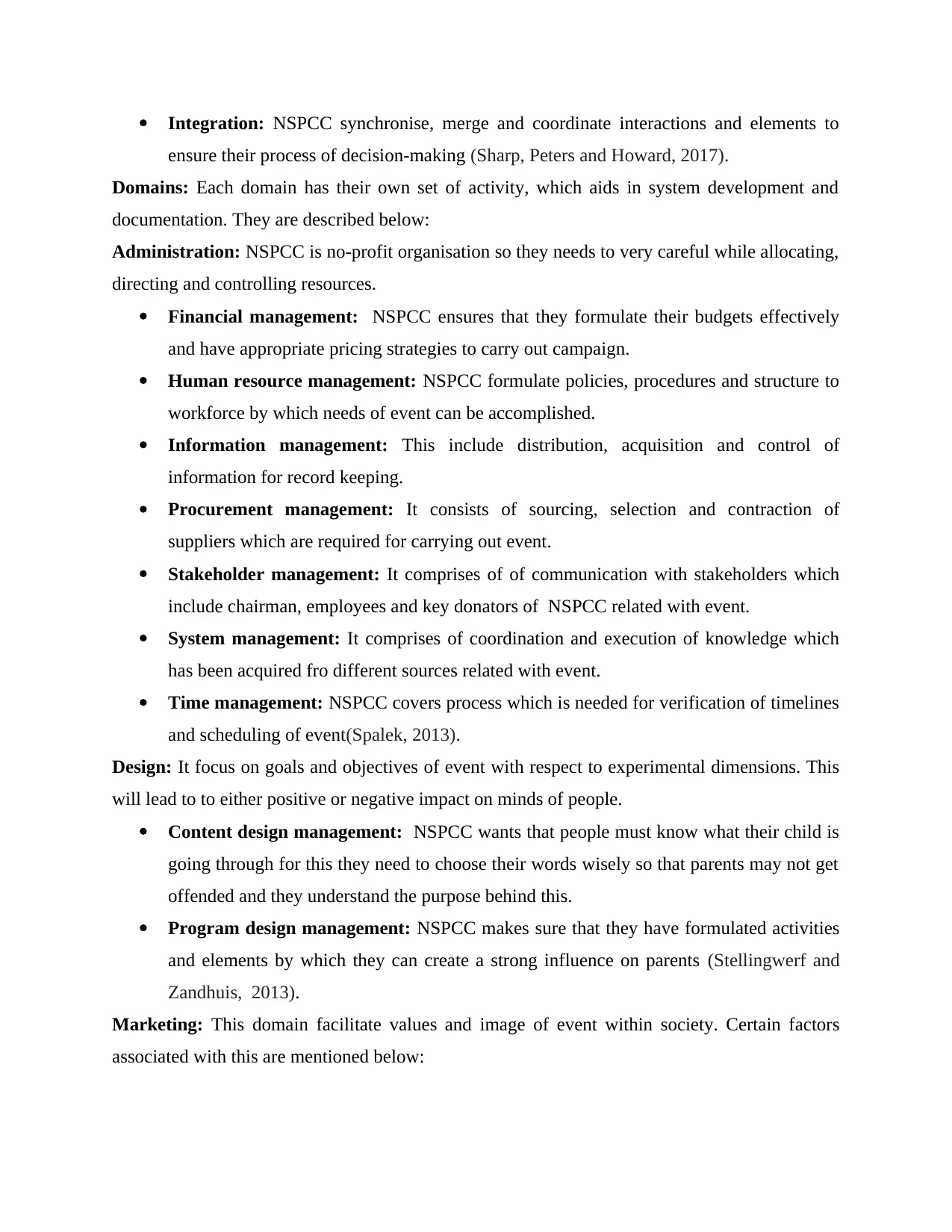
Integration: NSPCC synchronise, merge and coordinate interactions and elements to
ensure their process of decision-making (Sharp, Peters and Howard, 2017).
Domains: Each domain has their own set of activity, which aids in system development and
documentation. They are described below:
Administration: NSPCC is no-profit organisation so they needs to very careful while allocating,
directing and controlling resources.
Financial management: NSPCC ensures that they formulate their budgets effectively
and have appropriate pricing strategies to carry out campaign.
Human resource management: NSPCC formulate policies, procedures and structure to
workforce by which needs of event can be accomplished.
Information management: This include distribution, acquisition and control of
information for record keeping.
Procurement management: It consists of sourcing, selection and contraction of
suppliers which are required for carrying out event.
Stakeholder management: It comprises of of communication with stakeholders which
include chairman, employees and key donators of NSPCC related with event.
System management: It comprises of coordination and execution of knowledge which
has been acquired fro different sources related with event.
Time management: NSPCC covers process which is needed for verification of timelines
and scheduling of event(Spalek, 2013).
Design: It focus on goals and objectives of event with respect to experimental dimensions. This
will lead to to either positive or negative impact on minds of people.
Content design management: NSPCC wants that people must know what their child is
going through for this they need to choose their words wisely so that parents may not get
offended and they understand the purpose behind this.
Program design management: NSPCC makes sure that they have formulated activities
and elements by which they can create a strong influence on parents (Stellingwerf and
Zandhuis, 2013).
Marketing: This domain facilitate values and image of event within society. Certain factors
associated with this are mentioned below:
ensure their process of decision-making (Sharp, Peters and Howard, 2017).
Domains: Each domain has their own set of activity, which aids in system development and
documentation. They are described below:
Administration: NSPCC is no-profit organisation so they needs to very careful while allocating,
directing and controlling resources.
Financial management: NSPCC ensures that they formulate their budgets effectively
and have appropriate pricing strategies to carry out campaign.
Human resource management: NSPCC formulate policies, procedures and structure to
workforce by which needs of event can be accomplished.
Information management: This include distribution, acquisition and control of
information for record keeping.
Procurement management: It consists of sourcing, selection and contraction of
suppliers which are required for carrying out event.
Stakeholder management: It comprises of of communication with stakeholders which
include chairman, employees and key donators of NSPCC related with event.
System management: It comprises of coordination and execution of knowledge which
has been acquired fro different sources related with event.
Time management: NSPCC covers process which is needed for verification of timelines
and scheduling of event(Spalek, 2013).
Design: It focus on goals and objectives of event with respect to experimental dimensions. This
will lead to to either positive or negative impact on minds of people.
Content design management: NSPCC wants that people must know what their child is
going through for this they need to choose their words wisely so that parents may not get
offended and they understand the purpose behind this.
Program design management: NSPCC makes sure that they have formulated activities
and elements by which they can create a strong influence on parents (Stellingwerf and
Zandhuis, 2013).
Marketing: This domain facilitate values and image of event within society. Certain factors
associated with this are mentioned below:
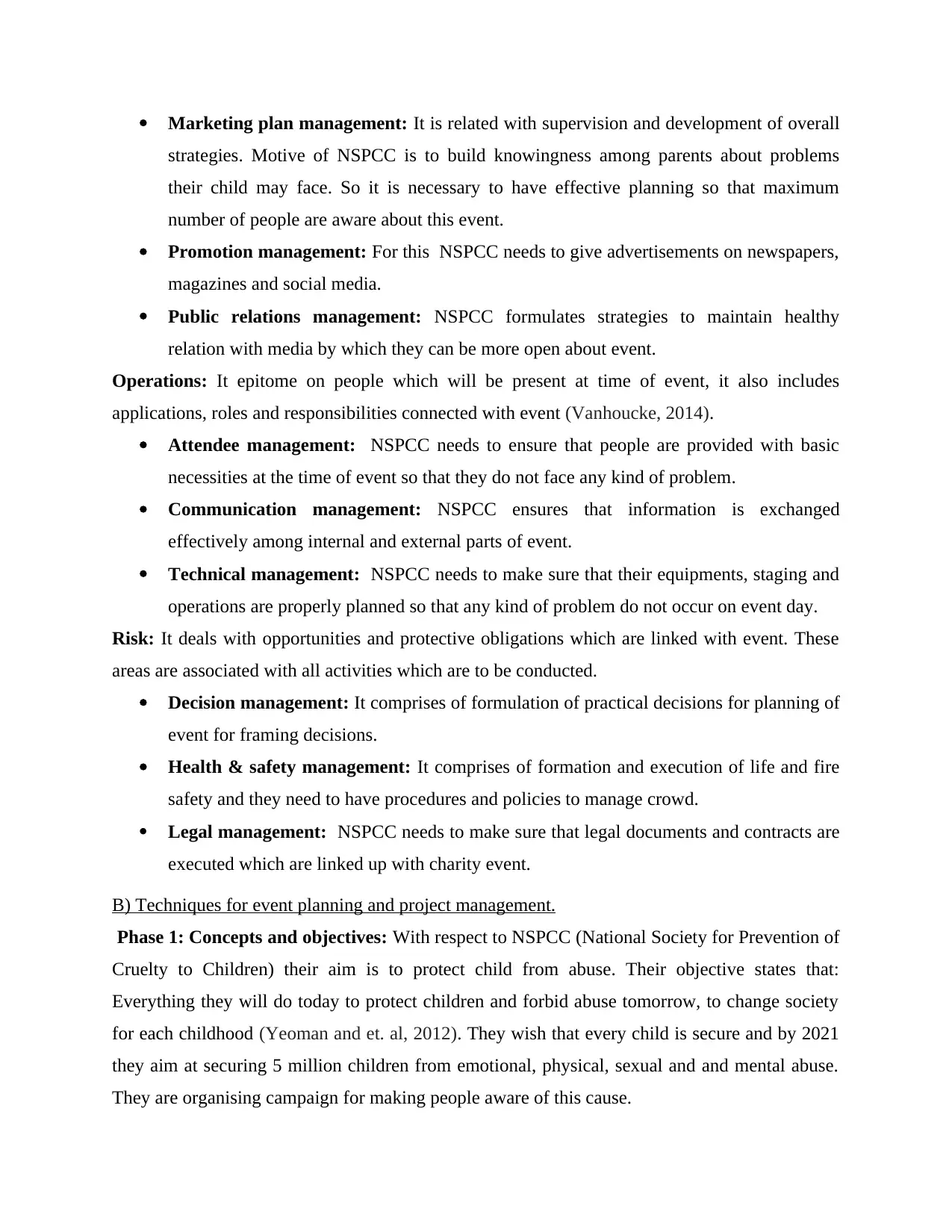
Marketing plan management: It is related with supervision and development of overall
strategies. Motive of NSPCC is to build knowingness among parents about problems
their child may face. So it is necessary to have effective planning so that maximum
number of people are aware about this event.
Promotion management: For this NSPCC needs to give advertisements on newspapers,
magazines and social media.
Public relations management: NSPCC formulates strategies to maintain healthy
relation with media by which they can be more open about event.
Operations: It epitome on people which will be present at time of event, it also includes
applications, roles and responsibilities connected with event (Vanhoucke, 2014).
Attendee management: NSPCC needs to ensure that people are provided with basic
necessities at the time of event so that they do not face any kind of problem.
Communication management: NSPCC ensures that information is exchanged
effectively among internal and external parts of event.
Technical management: NSPCC needs to make sure that their equipments, staging and
operations are properly planned so that any kind of problem do not occur on event day.
Risk: It deals with opportunities and protective obligations which are linked with event. These
areas are associated with all activities which are to be conducted.
Decision management: It comprises of formulation of practical decisions for planning of
event for framing decisions.
Health & safety management: It comprises of formation and execution of life and fire
safety and they need to have procedures and policies to manage crowd.
Legal management: NSPCC needs to make sure that legal documents and contracts are
executed which are linked up with charity event.
B) Techniques for event planning and project management.
Phase 1: Concepts and objectives: With respect to NSPCC (National Society for Prevention of
Cruelty to Children) their aim is to protect child from abuse. Their objective states that:
Everything they will do today to protect children and forbid abuse tomorrow, to change society
for each childhood (Yeoman and et. al, 2012). They wish that every child is secure and by 2021
they aim at securing 5 million children from emotional, physical, sexual and and mental abuse.
They are organising campaign for making people aware of this cause.
strategies. Motive of NSPCC is to build knowingness among parents about problems
their child may face. So it is necessary to have effective planning so that maximum
number of people are aware about this event.
Promotion management: For this NSPCC needs to give advertisements on newspapers,
magazines and social media.
Public relations management: NSPCC formulates strategies to maintain healthy
relation with media by which they can be more open about event.
Operations: It epitome on people which will be present at time of event, it also includes
applications, roles and responsibilities connected with event (Vanhoucke, 2014).
Attendee management: NSPCC needs to ensure that people are provided with basic
necessities at the time of event so that they do not face any kind of problem.
Communication management: NSPCC ensures that information is exchanged
effectively among internal and external parts of event.
Technical management: NSPCC needs to make sure that their equipments, staging and
operations are properly planned so that any kind of problem do not occur on event day.
Risk: It deals with opportunities and protective obligations which are linked with event. These
areas are associated with all activities which are to be conducted.
Decision management: It comprises of formulation of practical decisions for planning of
event for framing decisions.
Health & safety management: It comprises of formation and execution of life and fire
safety and they need to have procedures and policies to manage crowd.
Legal management: NSPCC needs to make sure that legal documents and contracts are
executed which are linked up with charity event.
B) Techniques for event planning and project management.
Phase 1: Concepts and objectives: With respect to NSPCC (National Society for Prevention of
Cruelty to Children) their aim is to protect child from abuse. Their objective states that:
Everything they will do today to protect children and forbid abuse tomorrow, to change society
for each childhood (Yeoman and et. al, 2012). They wish that every child is secure and by 2021
they aim at securing 5 million children from emotional, physical, sexual and and mental abuse.
They are organising campaign for making people aware of this cause.
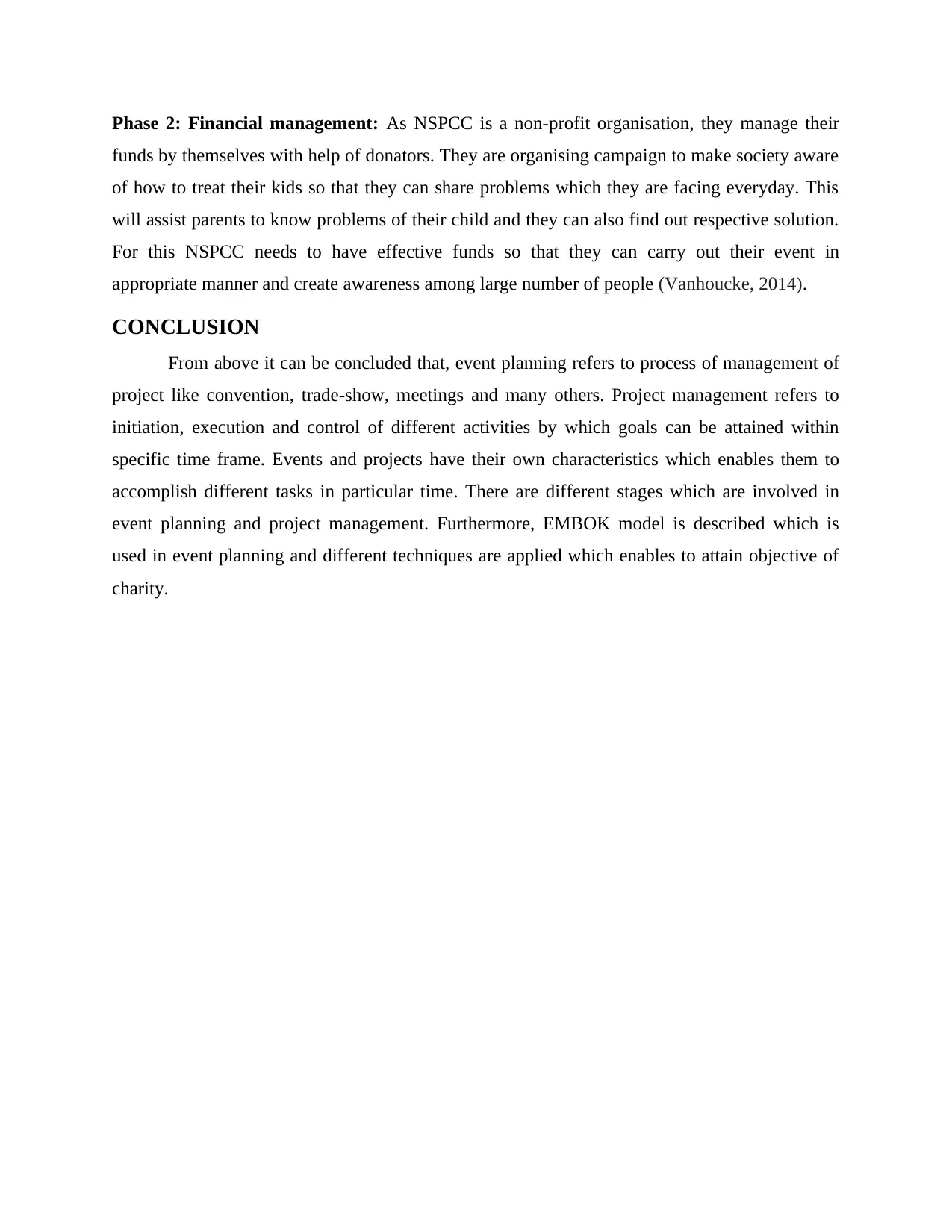
Phase 2: Financial management: As NSPCC is a non-profit organisation, they manage their
funds by themselves with help of donators. They are organising campaign to make society aware
of how to treat their kids so that they can share problems which they are facing everyday. This
will assist parents to know problems of their child and they can also find out respective solution.
For this NSPCC needs to have effective funds so that they can carry out their event in
appropriate manner and create awareness among large number of people (Vanhoucke, 2014).
CONCLUSION
From above it can be concluded that, event planning refers to process of management of
project like convention, trade-show, meetings and many others. Project management refers to
initiation, execution and control of different activities by which goals can be attained within
specific time frame. Events and projects have their own characteristics which enables them to
accomplish different tasks in particular time. There are different stages which are involved in
event planning and project management. Furthermore, EMBOK model is described which is
used in event planning and different techniques are applied which enables to attain objective of
charity.
funds by themselves with help of donators. They are organising campaign to make society aware
of how to treat their kids so that they can share problems which they are facing everyday. This
will assist parents to know problems of their child and they can also find out respective solution.
For this NSPCC needs to have effective funds so that they can carry out their event in
appropriate manner and create awareness among large number of people (Vanhoucke, 2014).
CONCLUSION
From above it can be concluded that, event planning refers to process of management of
project like convention, trade-show, meetings and many others. Project management refers to
initiation, execution and control of different activities by which goals can be attained within
specific time frame. Events and projects have their own characteristics which enables them to
accomplish different tasks in particular time. There are different stages which are involved in
event planning and project management. Furthermore, EMBOK model is described which is
used in event planning and different techniques are applied which enables to attain objective of
charity.
Paraphrase This Document
Need a fresh take? Get an instant paraphrase of this document with our AI Paraphraser
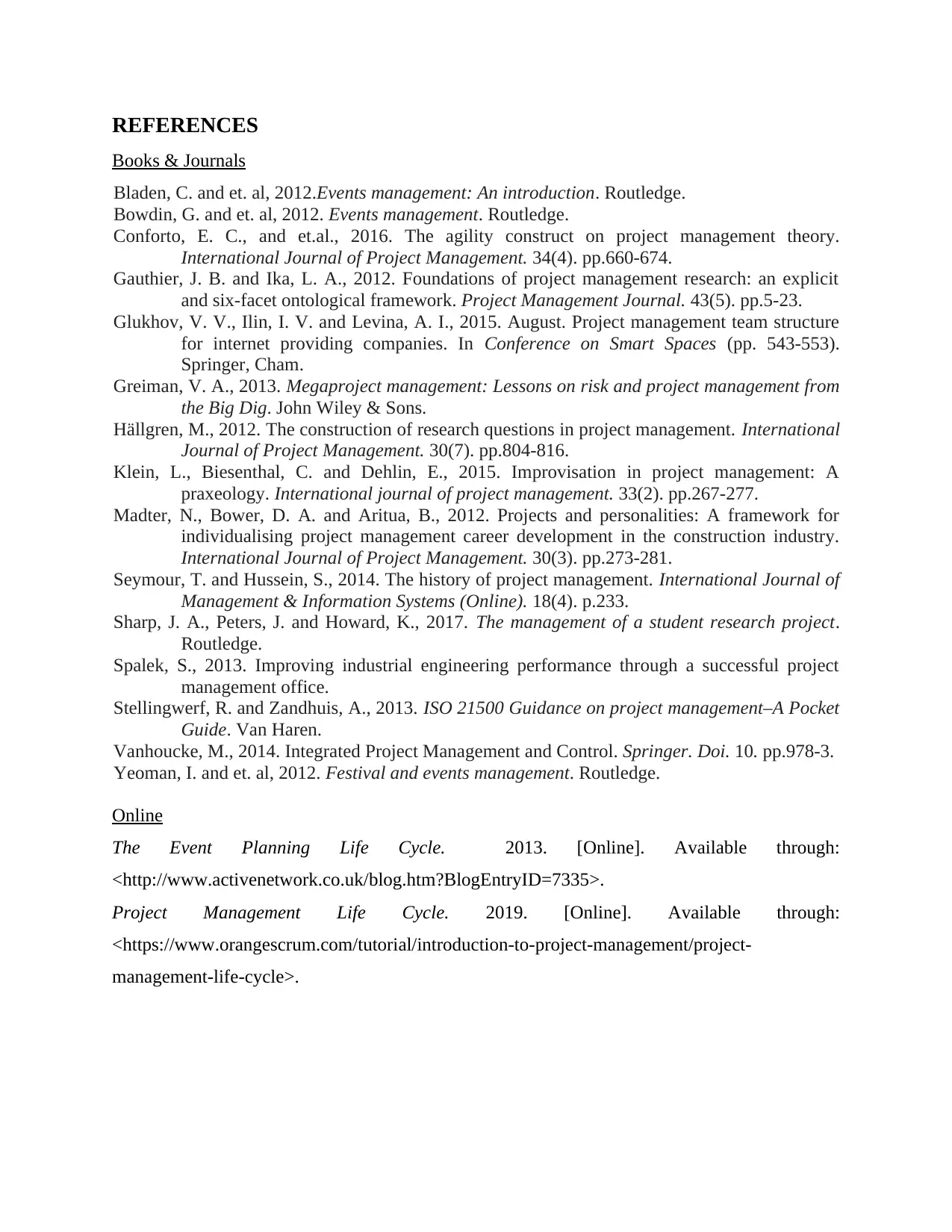
REFERENCES
Books & Journals
Bladen, C. and et. al, 2012.Events management: An introduction. Routledge.
Bowdin, G. and et. al, 2012. Events management. Routledge.
Conforto, E. C., and et.al., 2016. The agility construct on project management theory.
International Journal of Project Management. 34(4). pp.660-674.
Gauthier, J. B. and Ika, L. A., 2012. Foundations of project management research: an explicit
and six‐facet ontological framework. Project Management Journal. 43(5). pp.5-23.
Glukhov, V. V., Ilin, I. V. and Levina, A. I., 2015. August. Project management team structure
for internet providing companies. In Conference on Smart Spaces (pp. 543-553).
Springer, Cham.
Greiman, V. A., 2013. Megaproject management: Lessons on risk and project management from
the Big Dig. John Wiley & Sons.
Hällgren, M., 2012. The construction of research questions in project management. International
Journal of Project Management. 30(7). pp.804-816.
Klein, L., Biesenthal, C. and Dehlin, E., 2015. Improvisation in project management: A
praxeology. International journal of project management. 33(2). pp.267-277.
Madter, N., Bower, D. A. and Aritua, B., 2012. Projects and personalities: A framework for
individualising project management career development in the construction industry.
International Journal of Project Management. 30(3). pp.273-281.
Seymour, T. and Hussein, S., 2014. The history of project management. International Journal of
Management & Information Systems (Online). 18(4). p.233.
Sharp, J. A., Peters, J. and Howard, K., 2017. The management of a student research project.
Routledge.
Spalek, S., 2013. Improving industrial engineering performance through a successful project
management office.
Stellingwerf, R. and Zandhuis, A., 2013. ISO 21500 Guidance on project management–A Pocket
Guide. Van Haren.
Vanhoucke, M., 2014. Integrated Project Management and Control. Springer. Doi. 10. pp.978-3.
Yeoman, I. and et. al, 2012. Festival and events management. Routledge.
Online
The Event Planning Life Cycle. 2013. [Online]. Available through:
<http://www.activenetwork.co.uk/blog.htm?BlogEntryID=7335>.
Project Management Life Cycle. 2019. [Online]. Available through:
<https://www.orangescrum.com/tutorial/introduction-to-project-management/project-
management-life-cycle>.
Books & Journals
Bladen, C. and et. al, 2012.Events management: An introduction. Routledge.
Bowdin, G. and et. al, 2012. Events management. Routledge.
Conforto, E. C., and et.al., 2016. The agility construct on project management theory.
International Journal of Project Management. 34(4). pp.660-674.
Gauthier, J. B. and Ika, L. A., 2012. Foundations of project management research: an explicit
and six‐facet ontological framework. Project Management Journal. 43(5). pp.5-23.
Glukhov, V. V., Ilin, I. V. and Levina, A. I., 2015. August. Project management team structure
for internet providing companies. In Conference on Smart Spaces (pp. 543-553).
Springer, Cham.
Greiman, V. A., 2013. Megaproject management: Lessons on risk and project management from
the Big Dig. John Wiley & Sons.
Hällgren, M., 2012. The construction of research questions in project management. International
Journal of Project Management. 30(7). pp.804-816.
Klein, L., Biesenthal, C. and Dehlin, E., 2015. Improvisation in project management: A
praxeology. International journal of project management. 33(2). pp.267-277.
Madter, N., Bower, D. A. and Aritua, B., 2012. Projects and personalities: A framework for
individualising project management career development in the construction industry.
International Journal of Project Management. 30(3). pp.273-281.
Seymour, T. and Hussein, S., 2014. The history of project management. International Journal of
Management & Information Systems (Online). 18(4). p.233.
Sharp, J. A., Peters, J. and Howard, K., 2017. The management of a student research project.
Routledge.
Spalek, S., 2013. Improving industrial engineering performance through a successful project
management office.
Stellingwerf, R. and Zandhuis, A., 2013. ISO 21500 Guidance on project management–A Pocket
Guide. Van Haren.
Vanhoucke, M., 2014. Integrated Project Management and Control. Springer. Doi. 10. pp.978-3.
Yeoman, I. and et. al, 2012. Festival and events management. Routledge.
Online
The Event Planning Life Cycle. 2013. [Online]. Available through:
<http://www.activenetwork.co.uk/blog.htm?BlogEntryID=7335>.
Project Management Life Cycle. 2019. [Online]. Available through:
<https://www.orangescrum.com/tutorial/introduction-to-project-management/project-
management-life-cycle>.
1 out of 14
Related Documents
Your All-in-One AI-Powered Toolkit for Academic Success.
+13062052269
info@desklib.com
Available 24*7 on WhatsApp / Email
![[object Object]](/_next/static/media/star-bottom.7253800d.svg)
Unlock your academic potential
© 2024 | Zucol Services PVT LTD | All rights reserved.





